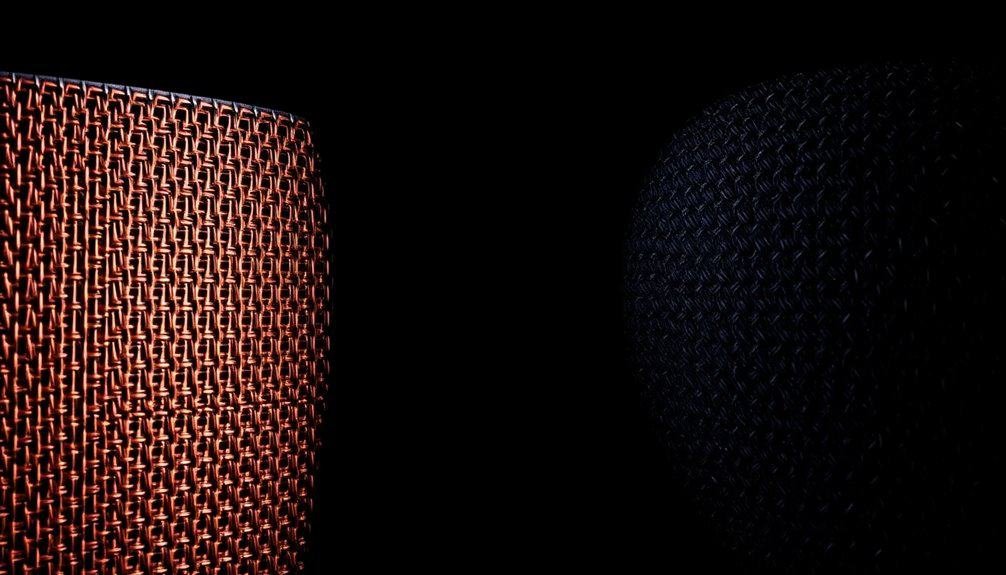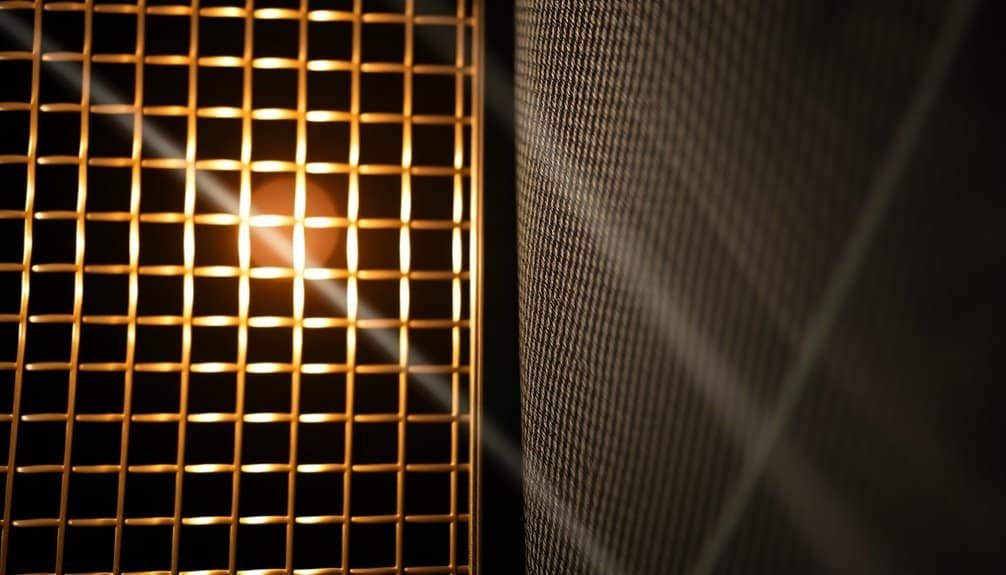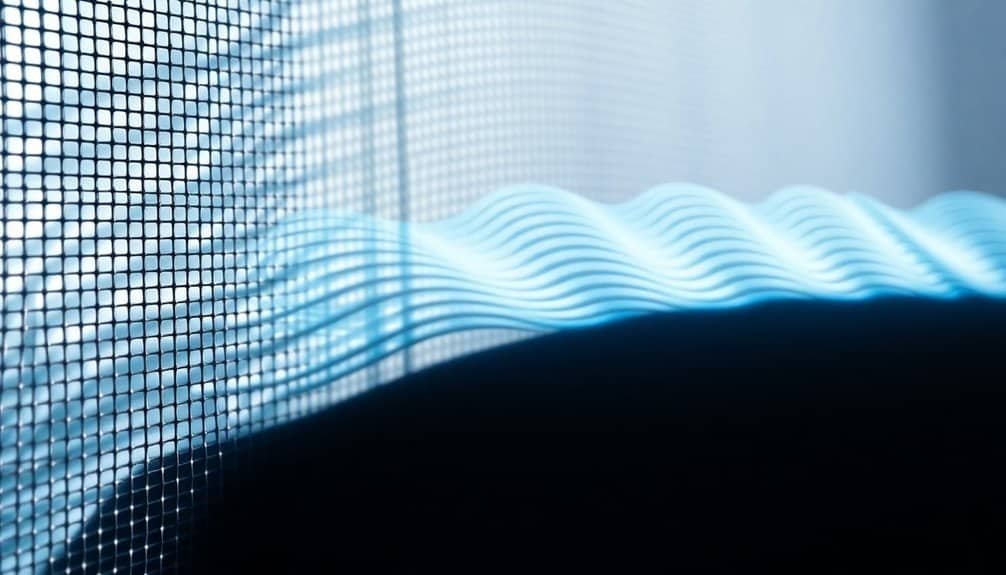EMF Blocking Vs Absorbing: Methods Explained
EMF protection involves blocking and absorbing methods. Blocking uses conductive materials like metal to reflect electromagnetic radiation, while absorbing materials convert EM energy into heat, reducing exposure.
Blocking is often more effective than absorbing, though effectiveness may vary based on material conductivity and design. Understanding these techniques can help determine which best suits your needs.
Disclaimer: As an affiliate, I may collect a share of sales from the links on this page.
Understanding EMF Blocking Methods

When you explore EMF blocking methods, you’ll find that conductive materials play an important role in shielding against electromagnetic waves. Silver, copper, and aluminum offer high conductivity, effectively reflecting these waves. When electromagnetic waves interact with these materials, mobile charge carriers redistribute, creating an opposing field that cancels incoming signals. The material’s conductivity level directly influences shielding effectiveness, with higher conductivity yielding better results. Natural non-polarized EMFs are essential for biological rhythmicity and well-being, which means that while shielding is important, balancing it with exposure to beneficial frequencies is crucial. Additionally, using metals such as aluminum and copper can significantly enhance the effectiveness of your shielding setup. Design considerations are vital; minimizing gaps in enclosures guarantees peak performance. For high-frequency applications, carefully crafted designs and surface treatments can combat issues like the skin effect, enhancing overall blocking efficiency.
The Faraday Cage Principle
A Faraday cage serves as an essential barrier against electromagnetic fields, effectively blocking external electrical forces. This protective enclosure uses conductive materials like aluminum, copper, or gold for best results. You’ll find that charges concentrate on the cage’s outer surface, canceling external charges inside. Electrostatic induction plays a role, causing internal charges to redistribute. For maximum effectiveness, verify the cage has a continuous conductive layer and consider grounding it to discharge accumulated charges. While Faraday cages excel in reducing electromagnetic radiation, their performance varies based on material thickness and conductivity, requiring careful selection for specific applications. In addition, the effectiveness of Faraday cages is influenced by factors such as the conductivity of the materials used and the size of holes in the mesh. Incorporating metal mesh configurations into the design can further enhance the shielding capabilities of the Faraday cage.
Shielding Effectiveness and Considerations

Understanding shielding effectiveness is essential for anyone working with electromagnetic interference (EMI). Shielding effectiveness measures how well a material protects against EMI, calculated by comparing signal strength before and after shielding.
Factors affecting this include material conductivity, magnetic permeability, and shield thickness. In environments with high EMI, like radiofrequency chambers, effective shielding is critical. The chosen materials, such as copper for conductive barriers or mu-metal for magnetic shielding, play a significant role in performance. Additionally, geometry influences effectiveness, with closed shapes generally providing better protection. EMF shielding paint is one method that can be utilized for outdoor applications to enhance shielding capabilities.
Testing methods vary, and practicality must balance effectiveness with cost considerations. EMI shielding is crucial for ensuring that sensitive electronic devices function correctly in challenging conditions.
EMF Absorbing Techniques
EMF absorbing techniques employ specific materials and methods to reduce electromagnetic radiation effectively. You can utilize various approaches to achieve better absorption results:
- Open Circuit Technique: Measures absorption by comparing incident, reflected, transmitted, and absorbed power.
- Short Circuit Technique: Uses a metal plate to assess only reflected and absorbed power.
- Impedance Matching: Guarantees peak absorption by matching input impedance to the characteristic impedance, roughly 377 Ω.
- Anisotropic Material Usage: Incorporates specialized materials that absorb EMF efficiently, minimizing destructive interference.
These methods enhance your understanding and application of EMF absorption technologies.
Comparing Blocking and Absorbing Methods

When evaluating EMF blocking and absorbing methods, it’s essential to recognize their distinct functions and applications.
Blocking materials, like copper and aluminum, reflect EM radiation, preventing it from entering or leaving a space. This makes them ideal for shielding enclosures.
In contrast, absorbing materials dissipate EM energy into heat. They excel in reducing EM pollution in environments needing energy dissipation.
When considering effectiveness, blocking methods typically outperform absorbing techniques in EM penetration prevention.
Understanding these differences helps you select the appropriate method based on your specific needs for EMF management in various applications, ensuring effective protection and energy control.
Design Considerations for Blocking Materials
Selecting the right blocking materials requires careful evaluation of several key factors.
You’ll want to verify the materials you choose effectively shield against electromagnetic interference. Consider these aspects:
- Conductive Properties: Materials like aluminum and copper excel at reflecting EMFs due to high conductivity.
- Cost-Effectiveness: Balance affordability and performance; copper and aluminum often provide that.
- Corrosion Resistance: Silver shields well but is pricier; often, it’s used as a coating.
- Structural Integrity: Strong materials like steel guarantee durability in shielding applications.
Evaluating these factors helps you achieve the best electromagnetic protection in your projects.
Design Considerations for Absorbing Materials
Design considerations for absorbing materials play a crucial role in their effectiveness. Material selection impacts absorption efficiency, with magnetic particles offering higher permeability.
Thickness optimization guarantees maximum absorption with minimal material, often utilizing advanced modeling techniques. The morphology and structure, especially with nanostructures, greatly influence EM wave interactions.
Surface characteristics matter too; coatings can minimize scattering. Impedance matching enhances absorption efficiency, while hybrid materials provide multi-functionality, like thermal management.
Finally, guaranteeing absorbers perform across specific frequency ranges is essential. By considering these factors, you can design more effective absorbing materials for various applications.
Applications and Benefits of Shielding Methods
As electromagnetic fields (EMF) become more prevalent in our daily lives, effective shielding methods have gained significant importance across various industries.
You can benefit from these applications:
- Healthcare: Protect medical devices, ensuring patient safety and functionality.
- Consumer Electronics: Minimize interference in smartphones and laptops, enhancing performance.
- Aerospace & Defense: Prevent malfunctions in critical systems, safeguarding data integrity.
- Automotive: Maintain reliable electronic systems, increasing vehicle safety.
These methods prevent equipment malfunctions, minimize data corruption, enhance safety, and improve reliability across various sectors, making EMF shielding indispensable in today’s technology-driven world.
Frequently Asked Questions
How Do I Assess the Effectiveness of an EMF Shielding Product?
To assess an EMF shielding product’s effectiveness, you need to measure signal strength variations inside and outside the shield. Testing methods like shielded room tests or attenuation calculations will provide reliable insights into its performance.
Can I DIY My Own EMF Blocking Solution at Home?
Yes, you can DIY your own EMF blocking solution at home. By using conductive materials like metals, fabrics, or paints, you’ll create effective barriers to shield yourself from electromagnetic fields and reduce exposure in your living space.
Are There Health Risks Associated With EMF Exposure?
You might wonder about health risks from EMF exposure. Current evidence suggests low-level exposure doesn’t cause harm. Significantly, studies haven’t confirmed a causal link between EMF exposure and symptoms like stress or headaches you may experience.
What Are the Best Practices for Maintaining EMF Shielding Materials?
Picture your EMF shielding materials as personal armor; to keep them effective, you’ll want to hand wash gently, avoid harsh chemicals, inspect regularly, and store properly. Maintenance guarantees your armor defends you well against EMF exposure.
How Do Environmental Factors Affect EMF Shielding Performance?
Environmental factors like temperature changes, humidity, and mechanical stress can greatly impact your EMF shielding. If you don’t consider these elements, materials may degrade, compromising effectiveness and potentially leaving you vulnerable to electromagnetic interference.
Conclusion
EMF blocking and absorbing techniques are crucial for managing electromagnetic exposure. Blocking methods, like Faraday cages, prevent signals from penetrating, while absorbing techniques convert EMF energy into heat.
Understanding these distinctions allows you to choose the right approach for your needs. By considering the design and applications of each method, you can enhance your environment against unwanted electromagnetic interference, improving health and productivity.


